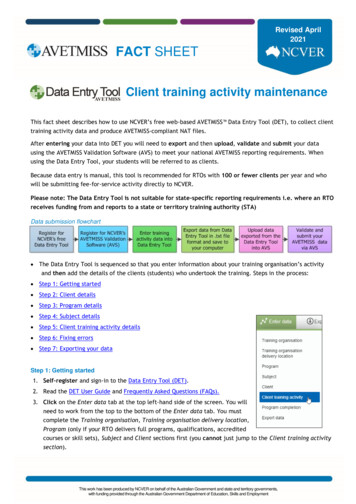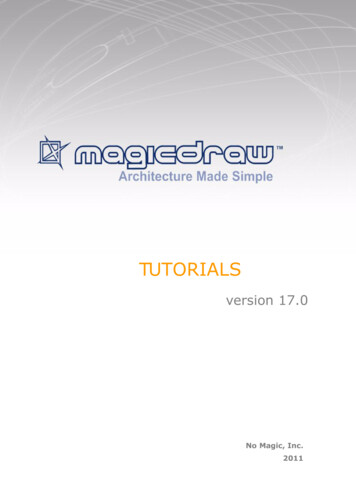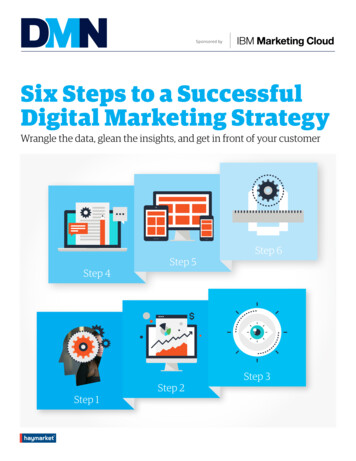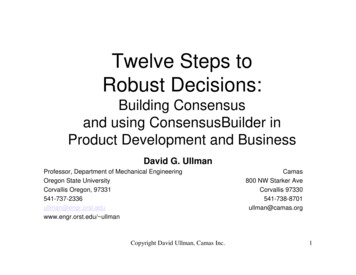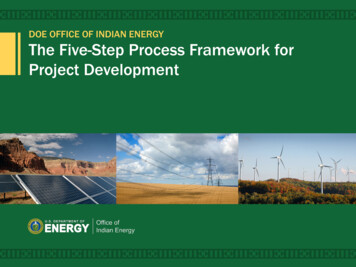
Transcription
DOE OFFICE OF INDIAN ENERGYThe Five-Step Process Framework forProject Development
Project Development Process: What Is It? Framework based on experience Focuses on key decision points Shows that project development is iterative Emphasizes that delaying or decidingagainst a project that does not meet currentgoals is a viable outcome and option2
Project Uncertainty/Capital at RiskDevelopmentConstructionProject OperationFinancial CloseUnknownsInvestmentStep 1, Step 2, Step 3Revenuepays offinvested Step 4Step 53
tion5Operations &Maintenance4
Step 1: Site, Scale, Resource, and Community Market perations &MaintenancePurpose: Determine whether basic elements for a successful project are in placeTasks:1. Identify possible sites for project locations2. Determine the energy load/demand for these sites using past electric bills forthese facilities3. Confirm renewable energy resource4. Review tribal facility electric cost data, regulations, and transmission andinterconnection requirements5. Evaluate community market potential for renewable sales. Your community isthe marketplace/energy –user.6. Assemble or communicate with the right team—those in positions or withknowledge to facilitate, approve, and champion the project5
Sizing Your Renewable Energy SystemCurrent LoadFuture Load Use your past monthlyenergy bills to determine thedemand. Start with yourstrategic energy plan At which energy scale doesyour community expect themost growth in energydemand? Consider your scale:residential, commercial, orindustrial How much will you need? Consider the current tariffstructure (how the energy ismetered and billed)Other Limiting Factors Interconnection Net metering cap Rebate limits6
Resource, Production & SavingsAssess available local energyresources Production– Online tools (PV Watts)– Field based measuring equipment– Resource maps7
Solar PV Energy Resource Mapping8
Wind Energy Resource Mapping: 80 m9
Local Site Considerations10
Local Site Considerations — Urban Centers11
Local Site Considerations — Rivers12
Local Site Considerations — Road Access13
Local Site Considerations — Suitable Area14
Initial Site Considerations — Example15
Initial Solar Site Considerations — Slope 5%16
Initial Wind Site Considerations — Slope 20%17
Wind Siting ObstructionsSource: OpenEI, Building.png18
Priorities: Where to Install Solar On the “built environment” where unshaded:– Existing building roofs that have an expected life of at least 15 moreyears and can accept added load - typically 2-4 pounds /ft2.Reduces solar load on building– All new buildings – all new buildings should be “solar ready See Solar Ready Buildings Planning �� Over parking areas– energy generation and nice amenity On compromised lands such as landfills and brownfields– Saves green-fields for nature– If installed on green fields, minimize site disturbance; plant nativelow height vegetation as needed19
Solar PV PlacementPhoto by Michael Deru. NREL 10075381PV Panels on Grand Ronde Tribal Housing Authority carport. Photo by GRTHA, NREL 11659046Facility Scale Hybrid System, NPS Range Station, San Miguel Island, CA.Photo by Kent Bullard, NREL 6325496Ballasted PV System on ESIF. Photo byDennis Schroeder, NREL 1316364020
Solar Photovoltaics (PV) Fixed Tilt/TrackingFixed Tilt Facing Equatortilt latitudetilt latitude for summer gaintilt latitude for winter gainOne Axis Trackingaround axis tilted or flatTwo Axis Trackingboth azimuth and altitude ofsun around two axes21
Solar Assessment: PV is VERY Shade SensitiveOnce preliminary siteassessment has beencompleted, you want to know: Estimated system size Estimated production(kilowatt-hour [kWh]/yr) Estimated cost Some economic analysisShade AnalyzerPhotos top to bottom: NREL 10314 and 1750922
PVWATTS Tool for Basic PV ModelingFree interactive map-based tool allows you to: Estimate expected monthly and annual solarresource values Quickly obtain performance estimates forgrid-connected PV systems Get a first cut of potential solar output Can identify potential incentives that a PV system ina particular area may be eligible for23
Activity Resource Map/Siting24
n5Operations &Maintenance25
Step 2: Roles, Business Structures, & Regulatory tionOperations &MaintenancePurpose: Determine ownership structure and permitting considerations if any.(Note: It is likely that internal tribal permitting is required if developed on tribal lands, however,state and federal permitting may be required if the Tribe is dealing with fee or trust land outsidethe tribal land holdings.)Tasks:1. Understand tribal role(s) and risk allocations/business structure2. Identify permitting needs and site use considerations3. Identify interconnection rules and net metering options with the local utilityOutputs:1. Clarify tribal roles2. Decide on business structure3. Understand the permit needs and process4. Understand interconnection and net-metering options26
PROJECT MEMBERSAND ROLES27
Potential Team Members Tribal Members– Leadership, staff, community members– Attorneys, engineers, professionals– Energy champions (key success component) Developer– Business managers, engineers, permitting specialists, investors, banks Utility– Attorneys, planning specialists, operations specialists, regulatoryspecialists, finance. Government– Tribal government, federal, state and local entities, regulating bodies(public utilities commission), Bureau of Indian Affairs, DOE.28
The Role of the Project ChampionEnsure allrelevant playersare engaged inthe project atthe right time,levels, androlesProjectChampionEngageTribal leadershipand project andbusinessmanagement(professionalsand staff)Employ relevantexpertise: legal andfinance; technical andconstruction;power marketing29
Tribal RolesMore Capital Intensive Owner/Operator Equity Investor LenderLess Capital Intensive Off-taker Land Owner O&M subcontractor30
PROJECT OWNERSHIPOPTIONS31
Importance of Choosing the RightOwnership Structure Protect tribal assets Preserve tribalsovereignty Minimize potentialliability Facilitate projectconstructionPhoto by Brian Hirsch, NREL 2089332
Evaluating Ownership OptionsBusiness StructureOptionSimplicityand QuickFormationShield TribalAssets rateBusinessfrom TribalControlAbility bdivision*Section 17Corporation*Tribal LawCorporation*State LawCorporationLLCs/Joint VentureLLC (only if Tribeis sole member)(*Can be protected by tribal sovereign immunity)33
Ownership Structure Resources Renewable Energy Development in Indian Country: A Handbookfor Tribes (Douglas MacCourt and Ater Wynne LLP)http://www.nrel.gov/docs/fy10osti/48078.pdf Tribal Business Structure Handbook (The Office of the AssistantSecretary – Indian Affairs U.S. Department of Interior)http://www.irs.gov/pub/irs-tege/tribal business structure handbook.pdf Structuring Tribal Business Enterprises and Joint Ventures(Kathleen M. Nilles, and Karen J. /pdfs/course biz0904 nilles.pdf Tribal Energy Development Primer (Quapaw Tribe of 34
INTERCONNECTION &NET METERING35
What Is Interconnection? An agreement required to connect your facility- orcommunity-scale system to the grid Distribution-level interconnection is largely the domain ofstate policy– Rules and regulations are highly variable between states Involve your utility early and often in the projectdevelopment process– Many utilities have their interconnection procedures and thenecessary contacts posted on their website Time, Technical Requirements and Cost36
Interconnection Installing a renewable energy project requires multiple approval and process steps, includinglocal permitting jurisdiction, installer, and utility. Four distinct steps:1.2.3.4.Utility interconnection application review and approval processConstructionFinal building inspection and paperwork submittal to utilityUtility permission to operate Usually takes approximately 15–20 days for residential and/or small commercial projects. Typically, one must obtain a building permit from the local jurisdiction and sign aninterconnection agreement with the local utility.Process for PV Building Permitting and Interconnection ExampleRetrieved from Ardani et al., “A state-level comparison of processes and timelines for distributed photovoltaic interconnection in the United States.” http://www.nrel.gov/docs/fy15osti/63556.pdf37
Net Metering Simple way for utilities to encouragecustomers to deploy on-site, grid-connectedgeneration (owned by the customer or a 3rdparty) and maximize value Excess generation flows to the grid and canbe credited back to the customer at thewholesale rate, retail rate or a higherincentive rate (or sometimes not at all) Often credit for net excess generation canbe carried over to future months Can improve the economics of small-scalerenewable power systems; may be a criticalelement in determining project economicfeasibilityIllustration by Ray David, NREL“Spinning the meter backwards”38
Net Metering Design ComponentsDesign Considerations EligibilityAllowable technologyo Customer typeo System size limitationsLimits on size of eligible residential andcommercial systemso Is oversizing of systems allowed?o Period of creditingoMonthly, annual, or continuousoRetail or wholesale rate Crediting of net excess generation Cap on aggregate net-metered capacity Additional fees (if any) Renewable energy credit (REC) ownership
PERMITTING40
Permitting and Regulatory Key nterconnectionIf on grid (with a utility)Communicate with utilityearly; this should be one ofthe first topics that isdiscussed and finalizedbefore constructionNet meteringIf available in state (check)Communicate with utilitybefore constructionLocal utilityLocal tribal andnon-tribalpermitting Internal tribal processapprovals For off-reservationprojects, state permitsmay applyDetermine permittingrequirements earlyTribal HistoricPreservation Office(THPO) and localtribal governmentEnvironmentalImpacts to: Wetlands/waterways Wildlife, habitat, flora Cultural resources May not be necessary Determine applicabilityearlyApplicablefederal agencyLocal utility41
Site Due erways Are there wetlands, water bodies, washes, arroyos, drainageconsiderations, or floodplain on site?Soils Soil conditions impact structural design and site feasibility Caliche or bedrock may require costly drilling Sandy soils may require deeper post embedment to meetwind and snow loading requirements Corrosive soils can require measures to protect embeddedpostsWildlife/habitat/flora Check for critical habitat, riparian areas, and endangeredspecies of flora or fauna that may be pper.jsp?Driveway/access Is a new driveway required? If so, is access available (limitedaccess highways may not allow a driveway)? Can equipment and materials be safely delivered to the sitewith no obstructions such as overhead utilities, trees, orvehicle weight limits?Check local, state, or federaltransportation department y.aspx42
Site Due Diligence cont.ConsiderationApplicability Are there easements or rights-of-ways for pipelines, utilities, orEasements/railroads that will be crossed or impacted?encumbrances/ Are there plans for road expansions or improvements, newrights-of-wayResourcesCheck with land managementauthorities, transportationplans, USGS mapspipelines, or future utility rights-of-ways at any time during thelife of the project?Culturalresources Are there known cultural resources on or near the site? If not,are further studies required?Tribal Historic /docs/Download.html(Google Earth layer)Land useand buildingpermits Building permit requirements Land use/zoning permits—Is the facility allowed as a primaryor accessory use? Is a special or conditional use permit orre-zoning required?Local tribal government Rights-of-way permits, including interconnection line, driveway,drainageStorm water Is the site one acre or more? If so, a construction storm waterpermit and mitigation measures are required Are measures such as retention ponds or swales required forerosion and sediment control or storm water mitigation duringand after tormwater/EPAConstruction-GeneralPermit.cfm43
When Will NEPA Apply to Tribes?The National Environmental Policy Act (NEPA) requires all federal agenciesto assess environmental impact of proposed actions Federal funding may trigger assessment for tribal projects (federalnexus, e.g. federal grants, BIA initiated/approved projects) Each federal agency may have its own particular NEPA procedure(check with appropriate agency) Timeline: Approx. 1–3 years depending on project size and complexity(unlikely for community scale) Recommendations:― Draft the Environmental Impact Statement concurrently with otherapplicable federal statutes and regulations― If necessary, work with NEPA experts to determine and prepare requiredanalysis44
NEPA cont.Three types in order of complexity and time:TypesComplexityTimelineCategorical exclusions (CX)— Categories of actions thatfederal agencies have determined do not have asignificant effect on the quality of the environment andneither an environmental assessment (EA) nor anenvironmental impact statement (EIS) is required.Does not require anypublic reviews,hearings, and unlessany ‘extraordinarycircumstances’ exist,an EA or an EIS is notrequired.The CategoricalExclusion ExceptionReview (CEER)conducted by the BIAis an internal two stepprocess and mainlyinvolves a simplecheck-box form.Environmental assessment (EA)— The document thatprovides sufficient analysis for determining whether aproposed action may or will have a significant impacton the quality of the environment and therefore requirethe preparation of an EIS.Usually requires a 30day public commentingperiod and may alsorequire a 14-30 dayscoping period upfront.Generally allow 6-9months for this processbefore issuing either aFONSI or proceed withan EIS.Environmental impact statement (EIS)— If an action isexpected to have significant impacts, or if the analysisin the EA identifies significant impacts, then an EIS willbe prepared.Requires morerigorous and expandedreview including publicinvolvement, publicmeetings andhearings.Generally should allow18 to 24 months forcompleting this ts/text/idc009157.pdf45
Categorical Exclusion ExamplesCATEGORICAL EXCLUSION DETERMINATIONSB5.16: Solar photovoltaic systems The installation, modification, operation, and removal of commercially available solar photovoltaicsystems located on a building or other structure (such as rooftop, parking lot or facility, and mounted tosignage, lighting, gates, or fences), or if located on land, generally comprising less than 10 acres withina previously disturbed or developed area. Covered actions would be in accordance with applicablerequirements (such as local land use and zoning requirements) in the proposed project area and wouldincorporate appropriate control technologies and best management practices.Recent Tribal Examples The Santo Domingo Tribe (Tribe) would utilize DOE and cost share funds for the planning, installation,and system performance evaluation of an approximate 115 kW DC ground mounted solar photovoltaic(PV) system that would power the Tribe’s community water pump and treatment (WPT) facility locatedat the Santo Domingo Pueblo in New Mexico The Tonto Apache Tribe (TAT) would utilize DOE and cost share funds to install commercially availablesolar thermal and solar photovoltaics (PV) at four of the tribe’s facilities. Under this project, theinstalled solar systems would be a mixture of roof mount, ground mount, and solar shade structurearrays on and around the four tribal buildings. The project would be located on the Tonto ApacheReservation in Payson, AZ at the Community Center, the Tonto Market, the Water Treatment Facility,and the Water Tower. Oneida Tribe of Indians of Wisconsin to install up to 695 kilowatts of grid-connected, solar electricmodules on the roofs of up to 9 Tribal facilities located in central and eastern portions of the al-exclusion-determinations-b51646
ation5Operations &Maintenance47
Step 3: Project Operations &MaintenancePurpose: Validate decisions and finalize project structureTasks:1. Finalize ownership structure and project team identification2. Finalize permitting, including environmental reviews, net metering, andinterconnection3. Finalize technology, financing, and development costsOutputs:1. Proposed financing/commitments and organization structure2. Detailed economic models3. Vendors selected4. Completed environmental reviews and finalized permits5. Net-metering and interconnection agreement6. Transmission finalized, if necessary48
FUNDING OPPORTUNITIES& FINANCING OPTIONS49
Paying for the ProjectThree Major Costs toDevelop a Project Feasibility – this is theproject potential analysis Preconstruction –permitting, environmental Construction –engineering, procurementof equipment, and actualconstruction of plantPV panels installed on Grand Ronde Tribal Housing Authority carport.42 kW: Combination of tribal funds and state incentivesPhoto from GRTHA, NREL 3179750
Project perationCash FlowsDevelopmentCostsCapitalInvestmentYear -7 -6 -5 -4 -3 -2 -1012345678910 11 12 13 14 15 16 17 18 19 2051
Project OwnershipFinancing structure is highly dependent on size of the project andthe capital available for a given project: Tribe owns the project Tribe hosts the project and buys the electricity Tribe partners with private sector and co-develops the project52
Direct Ownership StructurePrimarily for facility andcommunity-scale projectsProjectTribe purchases arenewable energy systemwith its own funding andpossibly other sourceslike grants.Over time, investmentrecouped from utility billsavingsTribe andElectricityUsersThe Tribe is the owner in thisstructure and self-generatesits electricityPaymentsUtilityRemainingEnergyNeeds53
Third-Party Power Purchase Agreement (PPA)The customer agrees to host the system and purchase the electricityRevenue fromelectricity salesHost(Tribal Entity)Remainingelectricity needsLocalUtility Renewable EnergyDeveloper andFinancial Partner(tax equity)Renewableelectricity atfixed pricesWorth 50 % of thecost of a solar systemVarious projectfinance structuresTaxBenefits54
Community Project PPA:Eventual Tribal Ownership ExampleDeveloper and investor form a project company (LLC) todevelop a wind or solar project Tribe as the host signs a PPA with the LLC to purchase theelectricity At end of 6 years (ITC) or 10 years (PTC)1) Investor ownership “flips” from 99% down to 5%2) Developer buys investor’s 5% ownership stake3) Developer now owns 100% of the project Developer can then sell project to Tribe– Project price is substantially reduced compared to the initial upfront costof the project55
Community (or Shared) Solar Usually an off-site solar project Taps into new markets ofcustomers Various ownership options Participants make a one-timeup-front payment or monthlypayments Participants receive a bill credit Example pricing:– 780 per solar panel– 3.15/Watt– 3 per 150 kWh per month National Community SolarPartnership“shared solar could represent 32%–49% ofthe distributed PV market in 2020”Source: http://www.nrel.gov/docs/fy15osti/63892.pdf56
Financing Options and Sources of Capital Internal tribal funds Grants Incentives (state, local, utility) Debt/loans Energy saving performance contacts (ESPCs) Tax equity incentives Monetizing green attributes (RECs)Project will likely involve a combination ofsources of capital57
Energy Savings Performance Contract (ESPC)An ESPC is a no up-front cost contracting mechanism between a site customer and anenergy service company (ESCO). Energy conservation measures and on-site generationare financed and implemented by an ESCO, which is repaid through energy savings.Site CustomerESPC PartnershipESCO and FinancialPartnerOver 90 DOE-Qualified ESCOs, including: View the full DOE ESPCs list at: ompanies58
Customer’s Cash FlowESPCs Reallocate Current and FutureEnergy Spending100%90%80%70%60%50%40%30%20%10%0%No ESPCDuring ESPCAfter ESPCCustomer's SavingsESCO Services Fee and FinancingEnergy and Operations and Maintenance Costs59
Renewable Energy Certificates (REC)Source: http://www.epa.gov/greenpower/gpmarket/rec chart.htm60
PROCUREMENT61
Procurement Process for Facility- andCommunity-Scale ProjectsStep 1:Develop andIssue RFPStep 2:MakeSelectionStep 3:NegotiateContractsPotential Project Partners to Procure Consider GSA as a resource for 98 Project developer Engineering, procurement, and construction (EPC)contractor Environmental permits contractor– May apply to some community projects, but not to others62
Request for Proposals (RFP) Process Outline1. Develop RFP― Timeline: 1 month to 1 year (depends on project scale and site complexity)― Who creates the RFP: project leader, contract officer/lawyer, site manager(s), energymanager and technology expert. RFP writers will receive input from utility, triballeaders, and stakeholders― RFP content2.Issue RFPTribal, federal, and industry networks3.Administer the RFP― Proposal meeting(s)― Site tour(s) – can be concurrent with proposal meeting― Q&A process – ensure all developers get same information4.Evaluate Criteria― Should be a clear process with well defined criteria― Evaluation panel recommended to consist of an odd number of members (typically3 to 7)5.Award ContractFour approaches63
mentation5Operations &Maintenance64
Step 4: tionOperations &MaintenancePurpose: Contract for and build the projectTasks: Finalize pre-construction activities including project agreements—financial, contractual, and interconnection Start construction and equipment installation Interconnect project to the grid Start project commissioning leading to facility/community projectoperationOutput: Completed project (operation)65
Implementation Activities Pre-construction― Financial closing (if applicable)― Project kickoff― Design and construction documents,plans/schedules, submittals Contract execution― Contract oversight/quality control― Change control Interconnection― Application review and approval process― Final building inspection― Paperwork submittal to utility Project Construction― Contract oversight/quality control― Change control Commissioning― Testing and verification― Interconnection verification (utility)― Utility permission to operate66
Pre-construction: Financial ClosingThe process of completing all project-related financial transactions,finalizing and closing the project financial accounts, disposing of projectassets, and releasing the work site.A few key steps: Establish and communicate final date for all financial transactions andaccount closings well before closing Verify all items from the statement of work have been completed beforedisbursing final payments Collect all financial records and verify that all financial obligations havebeen satisfied Close all financial accounts Transfer or dispose of assets according to the acquisition plan.67
Pre-construction: Project Kickoff and Design andConstruction Documents Kickoff meeting Checklists for schedules and each activity based on contract andproject documents Utility interconnection process and agreement Design (often in stages) and design approvals Other possible gementQuality controlCommissioningEnvironmental protectionSecurity68
Project Construction The system has received building approval from the localpermitting authority housing jurisdiction, but has not yetreceived final authorization for interconnection orpermission to operate Project developer orders equipment and beginsconstruction or installation Construction manager coordinates work of various trades Close coordination with tenants if site or building isoccupied Frequent communication between all parties to minimizepossible issues69
Commissioning To receive final interconnection authorization from a utility,the installer must first submit verification of passed finalbuilding inspection Project interconnected according to utility interconnectionagreement and utility process Commissioning– Physical inspection– Component Testing and whole system performance testing Upon approval of all paperwork, the utility will likely install anet meter (for net-metered systems) and finally issue apermission to operate letter. After permission is granted, the installer is allowed toenergize the system.70
Commissioning Process ExamplePlanningInvestigationImplementationHand-off andIntegration Determine objectives and strategies Assemble project team Compile and review documentation Conduct site assessment Develop functional test and monitoring plans Analyze test results Compile master list of deficiencies and recommend improvements Implement accepted recommendations Make repairs and improvements Retest and remonitor Fine-tune Present final documentation of commissioning effort71
Project Development Process5Operations tation5Operations &Maintenance72
Step 5: Operations & nOperations &MaintenancePurpose: Conduct or ensure ongoing operations andmaintenance (O&M), including repair and replacement (R&R)*Task: O&M agreementsWarrantiesMonitoring systemSystem performanceProduction guaranteesBuyout OptionsOutputs: Ensure responsible party carries out O&M/R&R*Measuring and tracking successCorrelate with business plan and strategic energy planContract complianceReporting of generationMet or exceeded energy and financial performancePhoto by Warren Getz, NREL 00180*Especially if owner – role of highest O&M risk73
Post-Procurement: Project O&M O&M agreements Warranties Monitoring system System performance Production guarantees Buyout options74
Drivers for Improved O&M Increase efficiency and energy delivery (kWh/kW) Decrease downtime (hours/year) Extend system lifetime (25–40 years) Reduce cost of O&M ( /kW/year) Ensure safety and reduce risk Enhance appearance and image Often required in financing and warranty75
SOLAR PV O&M76
Solar PV O&M Costs Depend On Location Remote Controlled access Restricted hours ofoperationSystem Type Roof Ground-mount Tracking vs. fixedComponents Number of modulesNumber of combinersNumber/type of invertersNumber of transformersEnvironmental Conditions SnowPollenBird populationsSand/dustHumidHotHigh windHailSalt airDiesel sootIndustrial emissionsConstruction site nearbyHigh insolationWarranty Coverage77
O&M Activities Administration–––– Billing; accountingHiring subcontractorsEnforcement of warrantiesManagement of budget and reservesMonitoring– Metering for revenue– Alarms– Diagnostics Preventive Maintenance– Scheduled and planned– Expenditure is budgeted Corrective Maintenance (repair)– Unplanned or condition-based– Possible expenditure is kept in reserveor line-of-credit– Must be timely and effectiveInspection of a 67-kW PV system at Mesa Verde National Park.Photo by Andy Walker, NREL78
Solar PV O&M Maintenance Plan ExampleTaskAs RequiredMonthly Inspect modules for damageAddress array shading issuesRemove debris around array Inspect array mounting systemAdjust array tilt Check inverter and/or charge controller for correct settingsInspect battery enclosureInspect battery terminals and connectionsEqualize batteriesWater batteriesMeasure specific gravity of each battery cell Load-test batteriesCapacity-test batteriesInspect and clean all electrical equipmentMonitor system for voltage and currentSemiannually *Adapted from Dunlop, J.P. (2010). Photovoltaic systems 2nd ed79
Solar PV O&M Depends on System Size Small system– On-site inspections, operational indicators ,and procedures (e.g., shade)responsibility of the off-taker; off-taker contacts provider if there is a problem– Inspection of fleets on a sample rather than every system– Performance guarantees consider insignificant corrections that can bedeferred; consider degradation rates specific to module type Large system– Emphasize automated monitoring and analytics, remote reset, push reports tostakeholders– Report loss of production daily; low production weekly (few false-positives)– Monitoring system: transparent, auditable, maintainable, backup, secure– On-site or remote sensing of environmental conditions (I, T) for large systems?80
Warran
1. Understand tribal role(s) and risk allocations/business structure 2. Identify permitting needs and site use considerations 3. Identify interconnection rules and net metering options with the local utility Outputs: 1. Clarify tribal roles 2. Decide on business




